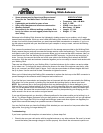
SPECIFICATIONS
• Frequency: 144—148 MHz
• Gain: 2.1dBi
• VSWR: Less than 1.5:1
• Max Power: 10 Watts
• Length: 57 21/4”
• Weight: 1.7 Lbs
WSA2M
Walking Stick Antenna
Welcome to the Walking Stick Antenna, the lightweight, durable answer to your outdoor, out-of range
transmit/receive problems. While you won’t need the Walking Stick Antenna in all situations it is advisable
to keep it on hand for those times when you need improved radio transmission or reception. If you’re us-
ing the antenna supplied with your hand-held and your reception is noisy or weak, connect the Walking
Stick as follows.
First, remove the antenna from your radio and place it in the storage area provided on the Walking Stick.
Simply remove the gray end cap to access the storage section under the handle grip. Then connect your
coax patch cord to your radio’s antenna connector where you just removed the radio’s antenna. Next, re-
move the dust cap from the Walking Stick to expose the BNC connector. Let the dust cap hang from its
chain. You can now connect the loose end of the coax cable to the Walking Stick antenna at the BNC
connection. With the radio and antenna connected together you’re now ready to transmit and receive with
your Walking Stick.
There are two different tips for your Walking Stick: A pointed aluminum tip for outdoor use and a rubber
tip for indoor use. To change tips simply remove the screw on the side of the antenna near the tip, slide
the tip out, reverse it and slide it back in place. You’ll note two screw holes at different heights that hold
the tip in place. Use the one that fits best. Remember to tighten the screw.
When you’re finished using the Walking Stick remember to replace the dust cap on the BNC connector to
prevent damage to the connector and to keep dust and moisture out.
If you find that your transmission and reception has not improved with the radio connected to the Walking
Stick when it is on the ground, try holding it by the handle and pointing the tip up above your head.
NOTE: Be sure there are no low hanging objects that may be damaged by or cause damage to your
Walking Stick (or you!) before holding it up in the air. Low lying electrical lines are a good thing to avoid!
Also, it is not advisable to hold the antenna up in the air during a thunderstorm or at any time when light-
ning is a threat. Be aware that some animals such as horses may be spooked by you swinging your an-
tenna around in the air so use caution and good sense!
If you are still hearing static you should try different positions for the antenna while you’re holding it up in
the air. Try different angles, distances from your body and turn around a central point until you get optimal
reception. Don’t forget that FM is line-of-sight and buildings, towers and other objects can degrade your
signal. Move several feet away from possible sources of interference.
You may find that when you have the Walking Stick attached you can transmit on low power rather than
high power, thus giving you longer battery life.
Troubleshooting:
If you have a problem with reception or transmission, try these steps first.
1. Check to be sure your radio works with its supplied antenna or any other antenna. Be sure it is turned
on and the battery has enough charge to function properly. Also check the volume and squelch con-
• Same antenna used by Search and Rescue teams!
• Tuned for the Two Meter Band: Full half wave an-
tenna!
• Lightweight and durable for years of use
• Heavy duty fiberglass and aluminum construction
• Weather resistant
• Reversible tip for different walking conditions: Rub-
ber tip for indoor use and rugged pointed tip for out-
door hiking




